Dealing with separation anxiety in toddlers can be challenging, but you can help ease their distress. Start by providing clear explanations about where you’re going and when you’ll return. Validate their feelings, and implement gradual separations to build their confidence. Consistent routines and fun goodbye rituals create a sense of security. If anxiety persists or escalates, consider seeking professional help. There’s much more to learn about supporting your child’s emotional well-being and managing these feelings effectively.
Key Takeaways
- Explain departures clearly to toddlers, reassuring them of your return to build trust and reduce anxiety.
- Validate their feelings, letting them know it’s okay to feel upset during separations.
- Start with brief separations and gradually increase the time apart to help them adjust.
- Create a consistent routine, incorporating special goodbye rituals to provide security during transitions.
- Introduce comfort objects, like a favorite toy, to help ease their feelings of separation.
Understanding Separation Anxiety in Toddlers
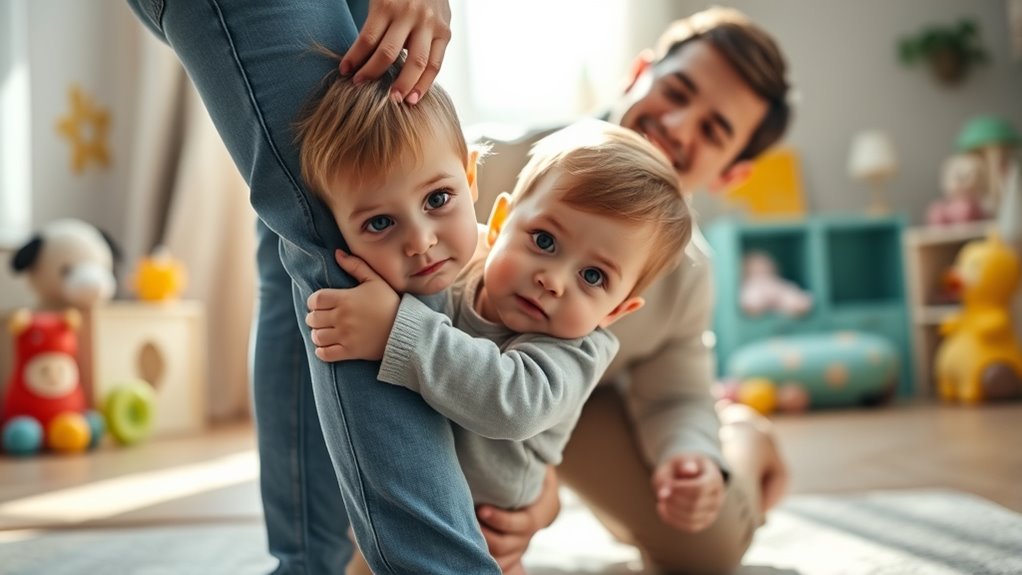
Understanding separation anxiety in toddlers can be crucial for both you and your child as they navigate this normal developmental stage. This anxiety typically arises between 6 and 12 months, peaking around 9 to 18 months, when toddlers realize that objects, including caregivers, still exist even when out of sight. They may fear losing you or perceive the environment as unsafe without your presence. Factors like environmental changes or stressful situations can intensify these feelings. A secure attachment to you plays a significant role in easing their anxiety, as children with strong emotional bonds tend to feel more secure during separations. Additionally, understanding the importance of emotional bonds can help you recognize how your child’s attachment to you influences their feelings of security. Establishing a consistent bedtime routine can also help ease separation anxiety by providing a sense of stability and predictability for your child. As your child grows, their emotional bonds strengthen, making separations more challenging. AI technologies can assist parents by analyzing children’s behavioral patterns to identify triggers of anxiety, thereby helping to support your child through their fears and foster a sense of security. Engaging in activities that promote emotional well-being can also enhance your child’s resilience during separations.
Recognizing Symptoms of Separation Anxiety
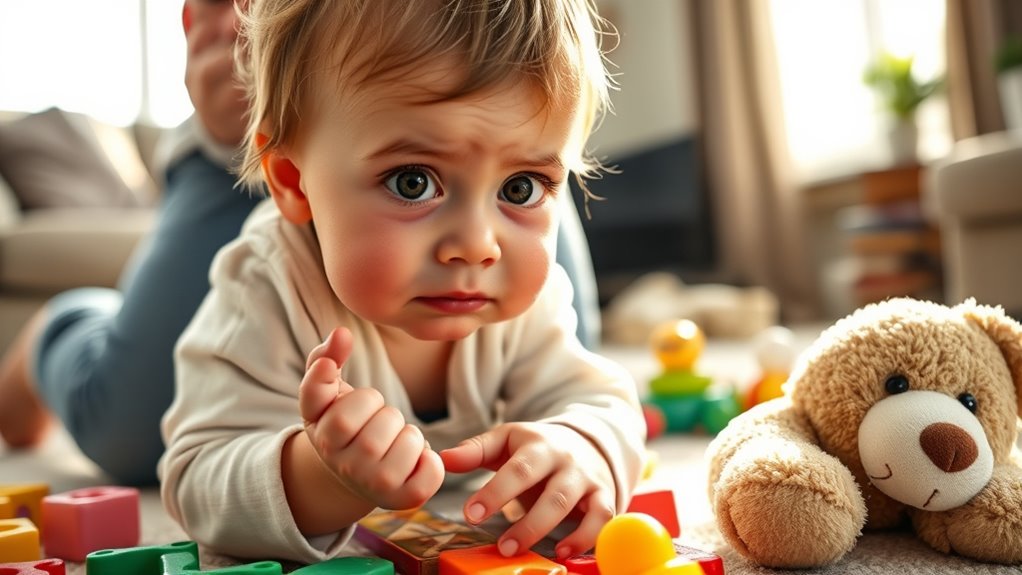
How can you tell if your toddler is experiencing separation anxiety? Look for signs like excessive clinging or tantrums when you’re about to leave.
Look for signs of separation anxiety in your toddler, such as excessive clinging or tantrums during departures.
If your child cries or becomes distressed even in familiar places, it’s a strong indicator. You might notice they resist being comforted by others or have a fear of being alone or with strangers. Additionally, this behavior can be linked to their emotional regulation, as toddlers are still developing the ability to manage their feelings effectively. Humor can also play a role in helping children cope with anxiety by providing a playful distraction.
Sleep disturbances, like difficulty falling asleep without you nearby, are also common. Emotional signs include anxiety about being apart and nightmares related to separation.
Physical complaints like stomachaches or headaches may arise, especially during separation events. Recognizing these symptoms early can help you provide the support your toddler needs as they navigate this challenging phase. Additionally, understanding that emotional and psychological growth occurs in stages can help you respond appropriately to your child’s needs during this time.
Normal Developmental Phase of Separation Anxiety

Separation anxiety is a typical part of your toddler’s development, often emerging as they grow more aware of their surroundings and relationships. This phase usually starts around 6 to 12 months, peaking between 10 and 18 months.
Your child’s emotional attachment to you intensifies their anxiety when you’re apart, as they struggle with the concept of object permanence. They may fear that your absence means you’re gone forever. During this time, creating a safe environment can help alleviate some of their anxiety during separations, as it provides them with a sense of security and comfort. Research has shown that emotional support during this phase is crucial for helping children cope with separation. Additionally, establishing consistent routines can play a significant role in fostering a sense of stability in your toddler’s life.
By the time they reach 2 to 3 years old, most children begin to grasp that separations are temporary. However, new environments or changes, like starting daycare, can reignite these feelings. Understanding this normal phase helps you support your toddler as they learn to navigate independence and security. Additionally, providing a consistent routine can further ease the transition and reduce feelings of anxiety.
Effective Strategies for Managing Separation Anxiety
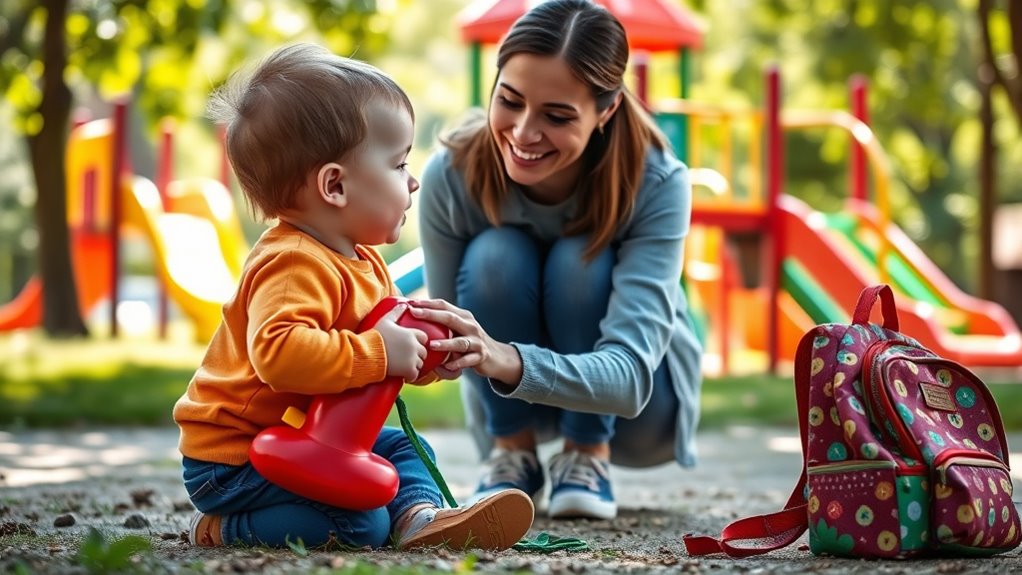
As toddlers begin to understand that separations are temporary, it’s important to equip them with strategies to manage their anxiety. Start by giving clear explanations about where you’re going and when you’ll return. Use reassuring language to comfort them, and discuss future reunions to create something to look forward to. Incorporating healthy routines can also provide a sense of stability that helps ease their anxiety. Establishing a supportive community can further enhance their emotional resilience during this time.
Validate their feelings to help them feel understood. Implement gradual separations, starting small and increasing the time apart. Playful games like peek-a-boo and hide and seek can make separations feel fun. Research indicates that emotional well-being is crucial for children as they navigate these experiences. Also, maintaining user privacy during these interactions can help create a safe environment for children to express their feelings.
Introduce comfort objects to soothe them, and guarantee goodbyes are positive. Finally, praise their efforts to cope, fostering their confidence and independence as they learn to manage their feelings during separations. Additionally, as recent trends show, strong demand and absorption in the market can lead to increased volatility that mirrors the emotional fluctuations toddlers experience during times of separation.
Importance of Consistency and Routine
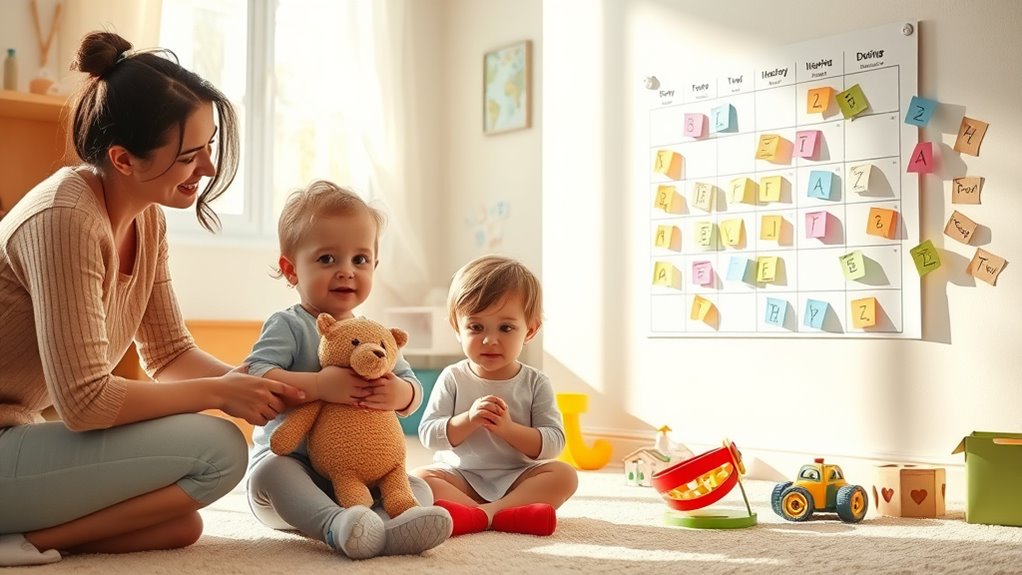
When you establish consistent routines for your toddler, you create a sense of security that can greatly reduce their anxiety. Predictable structures in their day help them feel in control, easing changes like drop-offs at daycare. Regular meal times, playtimes, and bedtimes contribute to a stable environment, making separations less intimidating. Consistency in drop-off and pick-up times builds trust, allowing your child to anticipate when you’ll return. Additionally, incorporating energy efficiency practices in your home can create a more comfortable and calming environment for your child. Effective ventilation improves air quality, which can positively impact your child’s mood and anxiety levels. Engaging in familiar activities, like a special goodbye ritual, can make separations smoother. By combining routines with emotional support, you reinforce your toddler’s confidence, helping them understand that separations are temporary. This sense of predictability can greatly ease their anxiety and foster resilience during these challenging moments. Additionally, creating living spaces that enhance quality of life can further contribute to a nurturing environment that supports your child’s emotional well-being. Decluttering your home can also promote a more organized space, leading to enhanced focus and productivity for both you and your child. Furthermore, establishing consistent routines enhances cultural intelligence, as it encourages children to navigate and adapt to diverse social environments more effectively.
When to Seek Professional Help
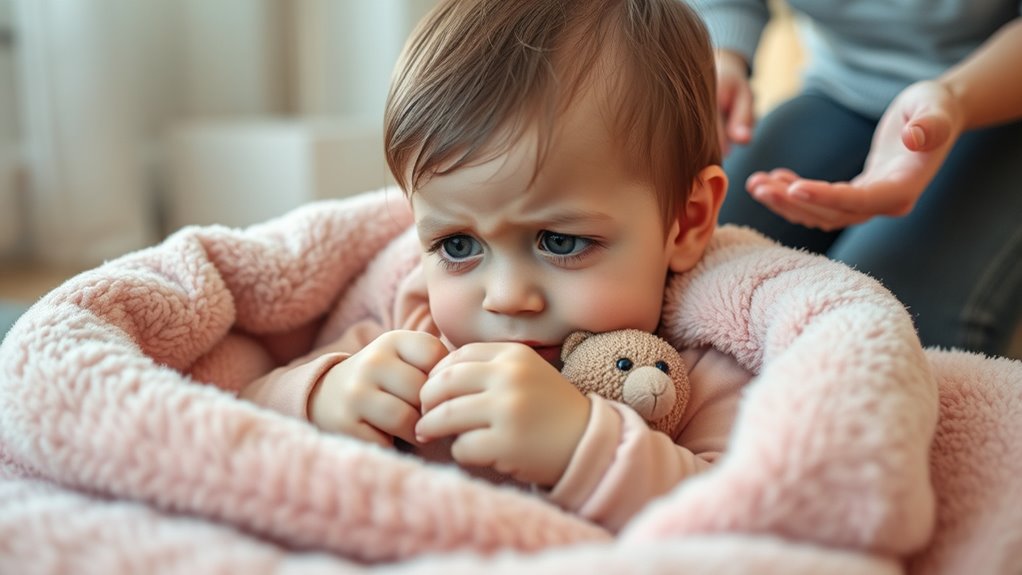
Creating a consistent routine can greatly ease your toddler’s anxiety, but sometimes the levels of distress may go beyond what’s typical for their age.
If your child shows intense fear about being away from home or refuses to leave, it might be time to seek professional help. Symptoms lasting more than four weeks, like nightmares, excessive worry, or physical complaints such as headaches, signal deeper issues.
If these anxieties disrupt daily life or school attendance, don’t hesitate to consult a pediatrician. Early intervention is essential to prevent more severe anxiety from developing.
Techniques for Gradual Separation
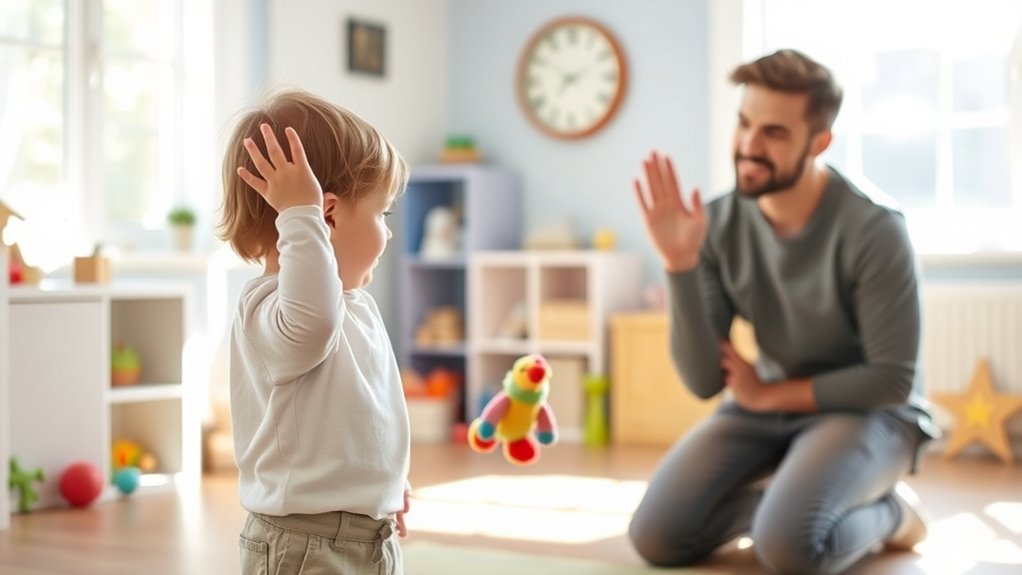
To help your toddler cope with separation anxiety, start with short separations that gradually increase in duration.
Begin by leaving them with familiar adults, like relatives or close friends, to build their trust. As they adjust, increase the distance and duration of your separations.
Praise your toddler for handling these moments well to boost their confidence. Consider developing a special goodbye ritual to ease changes, offering them a sense of security.
Consistent routines at home and school are essential, as predictability reduces anxiety. Communicate the routine to your child, so they know what to expect.
This step-by-step approach fosters comfort and helps your toddler gradually adapt to being apart from you.
Supporting Your Child’s Emotional Well-being

As your toddler becomes more comfortable with short separations, it’s important to focus on supporting their emotional well-being.
Recognize the signs of separation anxiety, like crying and clinging, and validate their feelings. Establishing consistent routines can provide a sense of security, while positive reinforcement encourages emotional resilience.
Recognizing signs of separation anxiety and validating emotions can help foster emotional resilience in your toddler.
Communicate openly; reassure your child that they’re safe and loved, and express confidence in their ability to cope. Keep goodbyes short and sweet to minimize distress.
Discuss their feelings and read books about separation to enhance emotional awareness. If anxiety persists, consider consulting a mental health professional to explore further support.
Frequently Asked Questions
What Are the Differences Between Separation Anxiety and General Anxiety?
Separation anxiety and general anxiety differ mainly in focus. When you experience separation anxiety, you feel intense fear about being away from loved ones, often leading to clinginess or distress.
In contrast, generalized anxiety encompasses a broader range of worries about daily life, like perfectionism and control issues.
While separation anxiety peaks during early childhood, generalized anxiety can arise at any age, affecting various aspects of life and requiring different management strategies.
Can Separation Anxiety Affect Sleep Patterns in Toddlers?
What if your child suddenly starts waking up multiple times at night, leaving you exhausted? You might be witnessing the effects of separation anxiety on their sleep patterns.
When toddlers experience this, they often resist bedtime, cry when you leave, and wake frequently. Your little one’s need for reassurance can disrupt their sleep, leading to daytime crankiness.
Understanding this connection is key to helping them feel secure and get the restful sleep they need.
How Long Does Separation Anxiety Typically Last?
Separation anxiety typically lasts from around 6 months to 3 years, peaking between 10 to 18 months.
You’ll notice that its intensity varies among children, and some might experience it longer due to individual factors.
Life changes, like starting daycare, can also prolong it.
It’s important to remember that this phase is a normal part of development, and with your support, it usually subsides as your child gains confidence in separation.
Are There Specific Toys That Can Help With Separation Anxiety?
Imagine a brave knight facing the dragon of anxiety. To conquer it, you arm yourself with special toys.
Soft loveys become your shield, offering comfort during scary moments. Sensory toys act as magical potions, calming your nerves.
Movement-based toys, like trusty steeds, help you build confidence. Fidget toys and visual calming items are your secret weapons, redirecting fear into focus.
With these tools, you’re ready to face any challenge that comes your way!
Can Siblings Influence a Toddler’s Separation Anxiety Levels?
Yes, siblings can definitely influence a toddler’s separation anxiety levels. Their interactions provide emotional support, helping toddlers feel more secure during separations.
However, sibling rivalry might heighten anxiety if tensions arise. Consistent routines and positive sibling interactions can foster a supportive environment, making separations easier.
You can also encourage older siblings to model coping strategies, which can help your toddler learn emotional regulation and reduce their anxiety when faced with separation.
Conclusion
In summary, steering through separation anxiety in toddlers can be challenging, but you’re not alone. Did you know that about 40% of toddlers experience significant anxiety when separated from their parents? By understanding this phase and applying consistent strategies, you can help your little one feel secure and confident. Remember, with patience and a supportive approach, you can turn those tearful goodbyes into smooth changes, paving the way for your child’s emotional growth and resilience.









